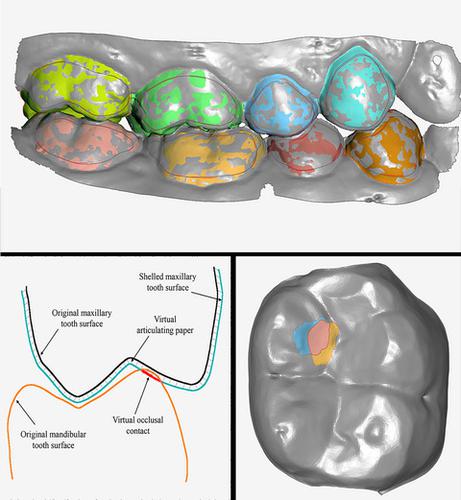当前位置:
X-MOL 学术
›
J. Oral Rehabil.
›
论文详情
Our official English website, www.x-mol.net, welcomes your
feedback! (Note: you will need to create a separate account there.)
Construction of virtual intercuspal occlusion: Considering tooth displacement
Journal of Oral Rehabilitation ( IF 3.1 ) Pub Date : 2021-01-23 , DOI: 10.1111/joor.13153 Linlin Li 1 , Hu Chen 1 , Yong Wang 1 , Yuchun Sun 1
Journal of Oral Rehabilitation ( IF 3.1 ) Pub Date : 2021-01-23 , DOI: 10.1111/joor.13153 Linlin Li 1 , Hu Chen 1 , Yong Wang 1 , Yuchun Sun 1
Affiliation

|
Common impressions cannot accurately duplicate the dental occlusion under occlusal force due to tooth displacement and mandibular deformation. To establish new methods to construct virtual intercuspal occlusion and assess their construction accuracy. The intraoral occlusal contacts of posterior teeth of 15 subjects were recorded with 8 μm and 100 μm articulating paper, respectively, and the marked teeth and buccal bite data were scanned with an intraoral scanner. The virtual dental occlusions were separately determined by buccal bite registration (BBR) method, and 3 new methods, namely segmented tooth registration (STR), occlusal contact areas (marked by 8 μm articulating paper) registration (OCR) and mixing registration (MR) methods. With the intraoral contact areas marked by 100 μm articulating paper set as reference and contact areas of the 4 virtual occlusions as tests, sensitivity, positive predictive value (PPV) and the ratio of overlapping areas were calculated. Kruskal‐Wallis test or 1‐way ANOVA was used to analyse the difference among groups. The sensitivity ranged from 0.69 to 0.94 and the PPV from 0.67 to 0.90. Sensitivity of OCR group and PPV of STR and OCR groups were different from that of BBR group at overlapping threshold of 50% (P = .028, .028 and .006). There was statistical difference of the ratio of overlapping areas over reference areas, and the values of STR and OCR groups were higher than that of BBR group (P = .045 and .021). The ability of STR and OCR methods to construct virtual intercuspal occlusion was better than BBR method.
中文翻译:

虚拟牙间咬合的构建:考虑牙齿移位
由于牙齿移位和下颌变形,普通印模无法在咬合力作用下精确地复制牙齿咬合。建立新的方法来构建虚拟的齿间咬合并评估其构建准确性。用8μm和100μm的咬合纸分别记录15位受试者的后牙的口腔内咬合,并使用口腔内扫描仪扫描标记的牙齿和颊咬合数据。虚拟牙齿咬合分别通过颊咬合(BBR)方法和3种新方法来确定,分别是分段牙齿对齐(STR),咬合接触区域(以8μm咬合纸标记),对齐(OCR)和混合对齐(MR)方法。将以100μm咬合纸标记的口内接触面积作为参考,并以4个虚拟咬合的接触面积作为测试,计算灵敏度,阳性预测值(PPV)和重叠区域的比率。使用Kruskal-Wallis检验或1方差分析法分析各组之间的差异。灵敏度范围为0.69至0.94,PPV为0.67至0.90。在重叠阈值为50%时,OCR组和STR和OCR组的PPV敏感性与BBR组的敏感性不同(P = .028,.028和.006)。重叠区域与参考区域的比率存在统计学差异,STR和OCR组的值高于BBR组(P = .045和.021)。STR和OCR方法构建虚拟齿间咬合的能力优于BBR方法。
更新日期:2021-01-23
中文翻译:

虚拟牙间咬合的构建:考虑牙齿移位
由于牙齿移位和下颌变形,普通印模无法在咬合力作用下精确地复制牙齿咬合。建立新的方法来构建虚拟的齿间咬合并评估其构建准确性。用8μm和100μm的咬合纸分别记录15位受试者的后牙的口腔内咬合,并使用口腔内扫描仪扫描标记的牙齿和颊咬合数据。虚拟牙齿咬合分别通过颊咬合(BBR)方法和3种新方法来确定,分别是分段牙齿对齐(STR),咬合接触区域(以8μm咬合纸标记),对齐(OCR)和混合对齐(MR)方法。将以100μm咬合纸标记的口内接触面积作为参考,并以4个虚拟咬合的接触面积作为测试,计算灵敏度,阳性预测值(PPV)和重叠区域的比率。使用Kruskal-Wallis检验或1方差分析法分析各组之间的差异。灵敏度范围为0.69至0.94,PPV为0.67至0.90。在重叠阈值为50%时,OCR组和STR和OCR组的PPV敏感性与BBR组的敏感性不同(P = .028,.028和.006)。重叠区域与参考区域的比率存在统计学差异,STR和OCR组的值高于BBR组(P = .045和.021)。STR和OCR方法构建虚拟齿间咬合的能力优于BBR方法。

















































 京公网安备 11010802027423号
京公网安备 11010802027423号